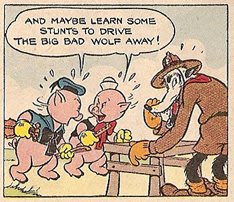The plot of the comics continuity bears almost no relation to the cartoon it accompanies other than the fact that the Big Bad Wolf's three sons are featured in both of them. While the cartoon is loosely inspired from the children's tale 'The Boy Who Cried Wolf', the continuity is actually composed of three successive episodes, the first two being very simplistic stories of the Wolf in disguise (first as a music teacher, then as a boy-scout trainer - it seems the Wolf is some kind of a forest Fantomas, the French pulp fiction / silent cinema 'master of disguises' anti-hero) kidnapping the two silly piglets who are promptly rescued by their vigilant 'big brother'. And yet, even though their stories might be simplistic not to say repetitious, these two episodes nevertheless have some moments of brillance, as in the below half-page:
Not only is the cruel irony in watching the piglets sing "Who's afraid of the Big Bad Wolf?" while trembling in fear in front of the Wolf is outstanding, but the Wolf's persona is embellished by having him wax poetically in a sarcastic tone ("music soothes the savage beast"). His cruelty is given a refined touch by his forcing his victims play music for his pleasure before he sets on devouring them. His remark "But I'm not savage! Only hungry!" is a self-conscious protest in advance for stereotyping him as a crude villain. All these points bring him closer to a Hannibal Lecter (or Fantomas) quality anti-hero than, say, the Leatherface of Texas Chain Saw Massacre. Well, of course, he is not exactly a Hannibal Lecter with all the non-pretensious, genuine aristocratic aura, but he is an exceptional figure defying the typecasting which comes with his social status (an outcast bum, basicly).
The below row of panels from a subsequent Sunday leaves no room for further comment on the depth of Wolf's wit, and consequently on his high-calibre persona, (and, conversely, on the piglets' stupidity):
This 1936 'Silly Symphony' continuity also boasts some interesting moments with regards to visual narration as well, as in the below panel where the Wolf winks at the readers!, not only underlining that he and only he is the 'master of ceremonies' here, but consequently also creating a shared extra-diegetic space between the fictional world of the comics and that of the reader, bonding himself with his readership:
The drawing art itself visibly improves within a span of several weeks with regards to the figure of the Big Bad Wolf. At the beginning of the continuity (see, for instance, the Sunday page at the top of this post), his nose is rubbbery, apparently more elongated and more thinner than we are now accustomed to. Towards the end of the second episode, however, his face has evolved with a more rounded nose, as can be seen below:
The second episode of the continuity ends with a helpless Big Bad Wolf getting a violent beating from the big brother pig:

The violence depicted at this episode finale is quite unusual and disturbing. 'Though violence has quite frequently been featured in Disney cartoons and comics, especially in the earlier, pre-war examples, those instances of violence have in most instances been of a caricaturized, fancy, non-realistic, hence 'cartoony' manner, just like in the 1938 cartoon Practical Pig -and its Sunday comics version- where the Big Bad Wolf gets another beating at the hands of the same pig but with soap rubbed to his mouth and his butt slammed with a brush while strapped to a fancy gizmo. On the other hand, here in the above example, while the pig's monologue might be regarded as funny in its sarcasm, there is nothing really 'funny' with the actual violent act itself, which is made more evident in the subsequent panel below depicting the wolf's consequent pain and suffering:
The third and the concluding episode of the continuity has got a more engaging story and hence I will post it here in its entirety. As the initial episodes of this continuity had featured the Wolf kidnapping the two silly piglets twice and the big brother pig rescuing them in both cases, the Wolf now comes to the logical conclusion that...

The above half-page continues in embelleshing the Wolf's persona, which I'd pointed out in my previous post regarding the earlier episodes of the same continuity, by making him display a cultivated wit ("I am not a sculpter like Rodin nor like the ancient Phidias! I lean more to the modern style which is more -uh- insidious!"). Also, note that the Wolf puts on an artist's costume not as a disguise this time, but because he just feels dressing up as such is appropriate for the occasion. And in the subsequent, below Sunday half-page, he displays a deliciously wicked sense of humour:

And, at last...

To be continued!..









No comments:
Post a Comment